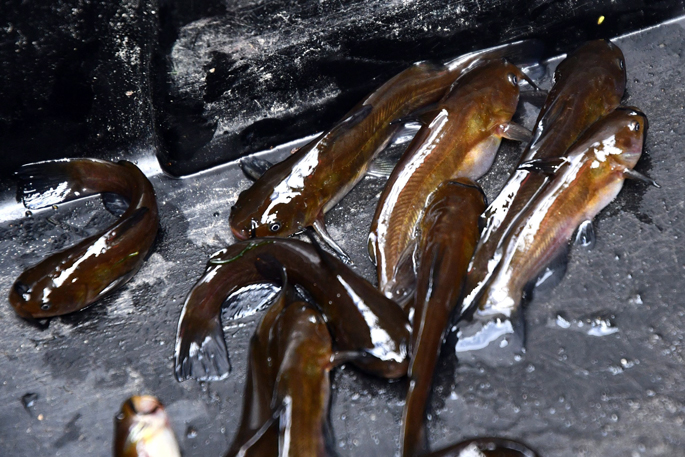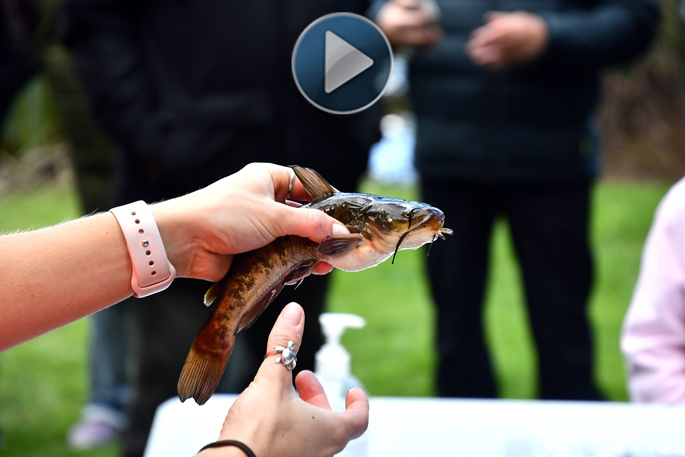The battle against an invasive species that has decimated kōura (freshwater crayfish) populations has taken centre stage in a centennial celebration.
Te Arawa whānau, marking 100 years of the iwi’s trust, have been learning about its Catfish Killas and kōura protectors.
While ensuring the environmental health of the rohe’s rotomoana is the trust’s priority, the man leading that mahi says it has also enabled the iwi to have “seats at decision-making tables”.
Standing at the Lake Rotoiti foreshore in Te Weta Bay on Saturday, Te Arawa Lakes Trust biosecurity and taiao (environment) restoration operations manager William Anaru told Local Democracy Reporting: “We’ve already lost so much when it comes to native species, our native taonga (treasure).”
Throughout March the trust celebrated the centennial by taking Te Arawa whānau out on the lake. Anaru was waiting for the last to arrive.
 Te Arawa Lakes Trust biosecurity and taiao restoration operations manager William Anaru. Photo / Laura Smith.
Te Arawa Lakes Trust biosecurity and taiao restoration operations manager William Anaru. Photo / Laura Smith.
The bay was an important location for the trust’s biosecurity work; nets lined jetty sides as part of the award-winning Catfish Killas programme.
It was established between the iwi and the Bay of Plenty Regional Council in 2016 – the year the species was first found in Rotoiti.
Anaru said new pests continually damaged the taiao and taonga species.
“In this lake we have lost about 99 per cent of our kōura (freshwater crayfish).
While past generations fed whānau and manuhiri (visitors) with the native cray, Anaru said that ability had “been taken away”, and that was why biosecurity was important.
“It’s why we are fighting so hard to keep anything new from coming into our lakes.”
The biggest impact a century of the trust had was enabling its people to be involved in decisions on lake management, he said.
The Te Arawa Lakes Settlement Act 2006 was a Crown apology for Te Tiriti o Waitangi breaches and vested Te Arawa lakebeds to the trust. Before then, the trust was known as Te Arawa Māori Trust Board.
“We’ve got seats at decision-making tables.”
The last month had been busy, he said, but happy.
Trust chairman Geoff Rolleston said the century had been significant.
 Te Arawa Lakes Trust chairman Geoff Rolleston. Photo / Laura Smith.
Te Arawa Lakes Trust chairman Geoff Rolleston. Photo / Laura Smith.
From world wars to pandemics, impacts were “devastating” to its population, the people and the whenua.
Development had a “real negative effect” on the rohe’s lakes and waterways, he said.
The purpose of the lake excursion was to give people a better idea of the “extent of the mahi our teams are performing”.
“And for myself, to get a far greater appreciation of the work being done on the ground.”
Rolleston said, more importantly, it was looking to the next 100 years.
“From today, we like to think we can inspire, we can show people what needs to be done to revitalise our waterways, our whenua, our waterbodies, our lakes.”
Rolleston took over from Te Arawa rangatira Taa [Sir] Toby Curtis, who died in 2022.
Curtis chaired the trust for 16 years and helped it fulfil its Treaty of Waitangi settlement mandate to support the recovery and wellbeing of the region’s lakes, as well as while the trust moved to take a wider role within the iwi in the last few years.
At his nehu, his son Piripi Curtis said he fought and struggled to “bring back our mana Māori motuhake (autonomy).”
Catfish Killas demonstrate mahi
Biosecurity officer Keeley Grantham joined Anaru in demonstrating the work the team did. The Te Weta Bay nets were waiting to be inspected.
Grantham said usually some of the 2500 children from the 36 schools involved checked for the invasive species, or programme volunteers including some of the nearby residents.
She hoisted the nets from the lakebed, careful not to release any of its guests.
 Kōura, a native taonga, are eaten by invasive catfish. Photo / Laura Smith.
Kōura, a native taonga, are eaten by invasive catfish. Photo / Laura Smith.
A mixed bag, native kōura and small fish swam and crawled with invaders. Catfish were the dominant catch.
Grantham said the up to 50cm long whiskered fish were prolific breeders and can produce up to 6000 offspring in a season.
Two years after being discovered in Lake Rotoiti they were found in Lake Rotorua in 2018.
Since the Rotoiti population was discovered, more than 250,000 have been removed from its water.
 Te Arawa Lakes Trust's Catfish Killas work to remove the slimy invasive species from the rohe. Photo / Laura Smith.
Te Arawa Lakes Trust's Catfish Killas work to remove the slimy invasive species from the rohe. Photo / Laura Smith.
Catfish prey on taonga species such as kōura, as evidenced during a dissection later in the afternoon when a cray tail was pulled from the belly of a catfish.
They are managed as both exclusion and progressive containment pests.
The Catfish Killas separate the introduced species from the overall catch and return the rest.
LDR is local body journalism co-funded by RNZ and NZ On Air.




4 comments
How?
Posted on 02-04-2024 18:12 | By morepork
Is it possible for a North American pest to arrive and thrive in our Lakes? I don't see this as "happenstance". I reckon its "enemy action", though I can't imagine what kind of disturbed soul would want to do it. Catfish Killas are using infertile males and netting as a possible control, but it remains to be seen how effective this will be. We need a species that doesn't eat koura but loves to eat catfish...
Cautionary tale
Posted on 03-04-2024 10:24 | By SonnyJim
Hoping for a marine animal that can eliminate a specific species cannot work as the horrid catfish evolved amongst predators in an eat-or-be-eaten environment, so they are 'wired' to survive. One must ask what effect trout may have had upon historic koura populations. Refer to the song "There was an old lady who swallowed a fly, ...
@Sonnyjim
Posted on 03-04-2024 12:14 | By morepork
I agree with your position on using one species against another (my comment was actually tongue-in-cheek...) but the alternative is to use chemicals, and that is probably just as dangerous. We can only hope that the Catfish Killas approach is successful.
Hmmm
Posted on 03-04-2024 14:41 | By Let's get real
Catfish are quite a prized reward for a days fishing in other parts of the world.
How about using them to fund the rehabilitation work from locally paid groups instead of taking funds from council coffers.
A fishing competition with a meal of Catfish at the end and a nominal entry fee would have a swifter effect than passive nets and could result in a much greater community buy-in to the project and might provide some genuine information about health and well-being of the lakes.
Or are we inventing a problem to create jobs and income...?
Leave a Comment
You must be logged in to make a comment.